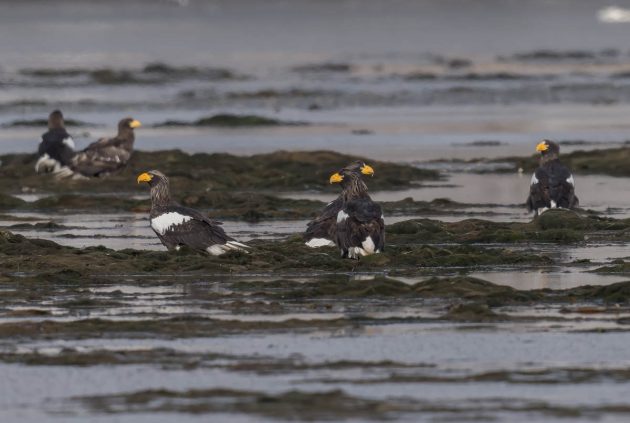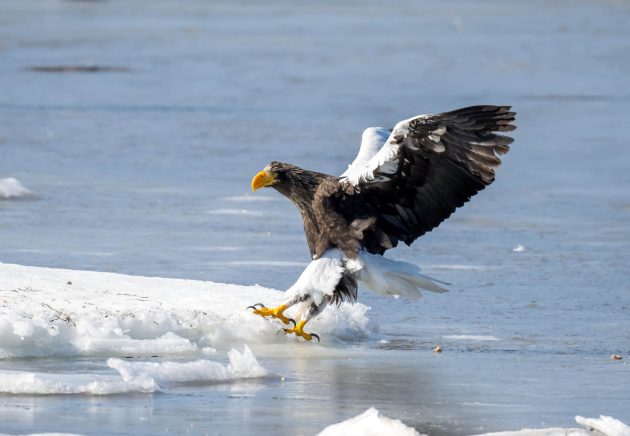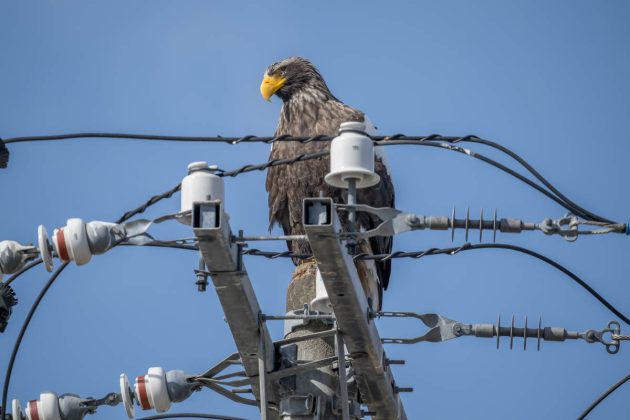Somehow, Steller’s Sea Eagle manages to look both fierce and slightly cartoonish. Maybe the latter is because the bird is so plump, or maybe it is because (at least to me) the head looks like it has been created by a somewhat amateurish wood carver.
The species is listed as Vulnerable – the estimated number of individuals is 4600-5100 (HBW), of which about 2000 winter on Hokkaido.


Georg Wilhelm Steller (1709 – 1746) was a German-born naturalist, though it seems he spent most of his (shortish) adult life in Russia, participating in the exploration of the North Pacific region.

In what might nowadays be regarded as a slightly weird scientific practice, after meeting naturalist Daniel Gottlieb Messerschmidt, he married Messerschmidt’s widow after his death and got notes from Messerschmidt’s Siberia travels from her that had not been handed over to the Imperial Academy of Sciences.

But marrying a widow and thus getting access to scientific information was not the only remarkable event in his life. He also

- Was possibly the first non-native to set foot on Alaskan soil
- Became shipwrecked on Bering island
- Survived a winter there living on sea lions, fur seals, and sea cows
- Left the island in a boat made from salvaged parts of the shipwreck
- Was falsely accused of freeing rebels from prison by a jealous rival
- Was put under arrest in Irkutsk
- Died of a fever in Siberia, aged 37.

Where is the movie about his life then?

Back to the eagle. There is a book on the species, but it is out of print and seems impossible to find even in online secondhand bookstores. If (like me) you want to feel bad about it, you may want to read the review of the book here.

Even the review has some interesting information – for example, a major predator of eagle nests is the Brown Bear.

It is even more specific, stating that brown bears depredate 20 % of offspring on Sakhalin Island (but not on the mainland).

Another danger to the species comes from lead poisoning as they eat the carcasses of deer killed by hunters (source).

The eagles do not breed on Hokkaido, spending only a few winter months there – so if you want to see courtship displays as described in here, you have to go further North a bit later in the year.

Finally, there is an interesting paper trying to estimate the economic value of a Steller’s Sea Eagle – in this case, a vagrant showing up in North America. The eagle spent nearly a month on the eastern seaboard of the USA, attracting thousands of birdwatchers. Via an online survey, these birdwatchers were asked about their expenses and their willingness to pay to see the eagle.

The result: The authors estimate that individual birdwatchers spent USD $180 ignoring travel time or $277 when accounting for travel time to view the eagle. They also estimate between 2115 and 2645 individuals traveled to see the eagle. Thus, the eagle generated a total expenditure between $380,604 and $476,626, or between $584,373 and $731,809 when accounting for travel time, and yielded what economists call a non-consumptive use consumer surplus between $139,036 and $174,114.

Not bad.

Bonus photos: One to annoy those people who do not like human items in bird photos …

… and one showing an embarrassing moment for an eagle, crashing into the ice.

Source link

